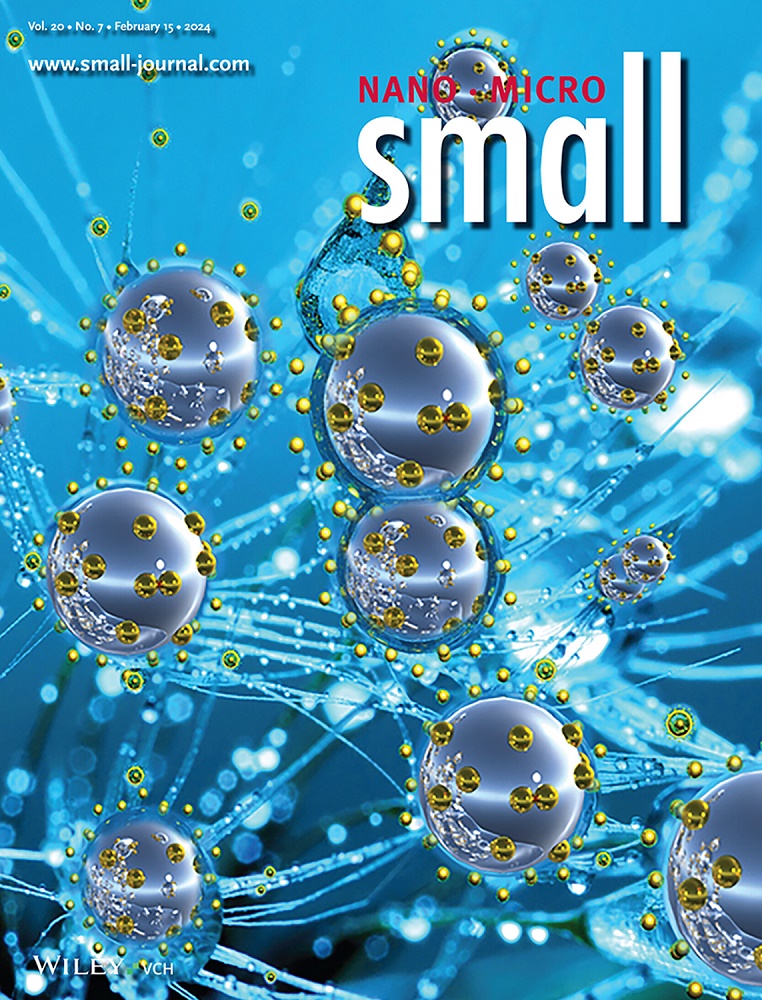Multifunctional CD‐MOF Hybrid Systems: Integrating Drug Delivery, Photothermal Therapy, and Nanozyme Applications
IF 12.1
2区 材料科学
Q1 CHEMISTRY, MULTIDISCIPLINARY
引用次数: 0
Abstract
A multifunctional hybrid platform is developed by integrating gold nanoparticles (AuNPs) and a lipid bilayer into cyclodextrin‐based metal‐organic frameworks (CD‐MOFs), with the objective of combining therapeutic and catalytic functionalities in a single system. The central hypothesis is that sequential surface engineering would enhance aqueous stability, enable responsive photothermal behavior, and allow for the controlled release of hydrophobic active compounds. To realize this, CD‐MOFs are first modified with a fluorocarbon layer to improve colloidal stability and encapsulation efficiency. Subsequently, a DPPC lipid bilayer is introduced to regulate release kinetics and further stabilize the particles. The incorporation of AuNPs endowed the hybrid with near‐infrared (NIR)‐responsive photothermal activity and peroxidase‐like catalytic behavior. Experimental data confirmed the efficient loading of compounds, improved structure retention under aqueous conditions, and rapid thermal response under NIR exposure. Furthermore, the hybrid structure exhibited catalytic activity across a broad pH range, maintaining its function even under conditions unfavorable to natural enzymes. These combined features demonstrate the potential of this modular CD‐MOF‐based architecture as an integrated therapeutic and catalytic platform. Its rational design and facile fabrication underscore its suitability for future applications in targeted therapy, controlled release systems, and bioinspired catalysis.多功能CD - MOF混合系统:整合药物输送,光热治疗和纳米酶应用
通过将金纳米颗粒(AuNPs)和脂质双分子层整合到环糊精基金属有机框架(CD - MOFs)中,开发了多功能混合平台,目的是在单一系统中结合治疗和催化功能。核心假设是,顺序表面工程将提高水稳定性,实现响应光热行为,并允许控制疏水活性化合物的释放。为了实现这一点,首先用氟碳层对CD - mof进行改性,以提高胶体稳定性和封装效率。随后,引入DPPC脂质双分子层来调节释放动力学并进一步稳定颗粒。AuNPs的掺入使该杂化物具有近红外(NIR)响应光热活性和类似过氧化物酶的催化行为。实验数据证实了化合物的有效负载,改善了水条件下的结构保留,以及近红外暴露下的快速热响应。此外,杂交结构在较宽的pH范围内表现出催化活性,即使在对天然酶不利的条件下也能保持其功能。这些综合功能表明了这种基于CD - MOF的模块化架构作为综合治疗和催化平台的潜力。其合理的设计和简单的制造强调了其在靶向治疗,控制释放系统和生物激发催化方面的未来应用的适用性。
本文章由计算机程序翻译,如有差异,请以英文原文为准。
求助全文
约1分钟内获得全文
求助全文
来源期刊

Small
工程技术-材料科学:综合
CiteScore
17.70
自引率
3.80%
发文量
1830
审稿时长
2.1 months
期刊介绍:
Small serves as an exceptional platform for both experimental and theoretical studies in fundamental and applied interdisciplinary research at the nano- and microscale. The journal offers a compelling mix of peer-reviewed Research Articles, Reviews, Perspectives, and Comments.
With a remarkable 2022 Journal Impact Factor of 13.3 (Journal Citation Reports from Clarivate Analytics, 2023), Small remains among the top multidisciplinary journals, covering a wide range of topics at the interface of materials science, chemistry, physics, engineering, medicine, and biology.
Small's readership includes biochemists, biologists, biomedical scientists, chemists, engineers, information technologists, materials scientists, physicists, and theoreticians alike.
 求助内容:
求助内容: 应助结果提醒方式:
应助结果提醒方式:


